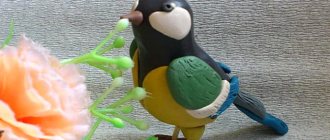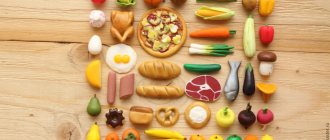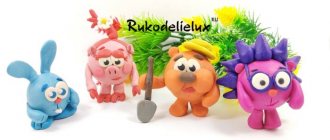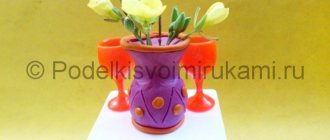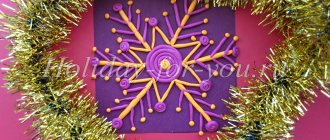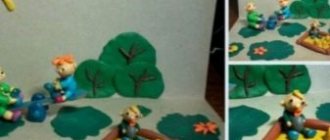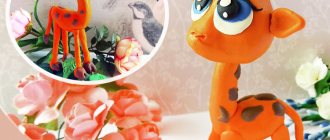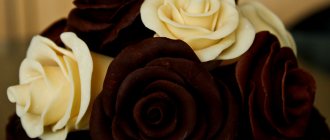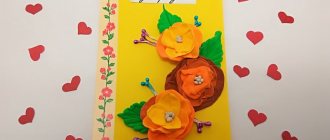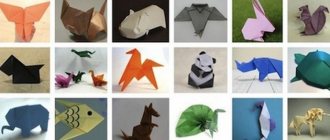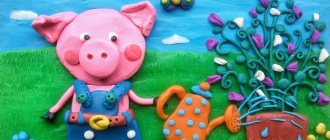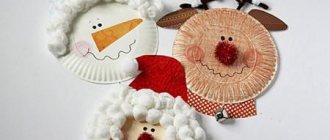For children of preschool age, you can come up with many entertaining activities, a special place among them is occupied by modeling from plasticine. Thanks to this type of creativity, parents will be able to instill in their child a love of creativity, develop fantasy, imagination, and fine motor skills. In addition, by making figures from plasticine, the baby learns to be independent.
Donut
You will need: plasticine of bright colors, a stick, a plastic spatula.
Master Class
- Roll out a ball of yellow plasticine.
- Flatten the workpiece and press the center with the round tip of the stack-bulk.
- Trim off excess plasticine from the back side.
- Make a cake from pink plasticine.
- Attach the doughnut to the donut base and make a hole in the center.
- Roll plasticine flagella in bright colors.
- Place the flagella in the freezer for 5 minutes.
- Remove and cut the frozen flagella into small pieces.
- Decorate the donut by adding sprinkles.
The plasticine donut is ready!
Husky
You will need: plasticine of gray, white, black, blue, red and yellow, toothpick, stacks.
Master Class
- Roll a ball of gray plasticine.
- Stack 2 triangles at the top of the ball.
- Attach 2 flat triangles of white plasticine.
- Cover the bottom of the ball with white plasticine.
- Roll out an oblong oval from white plasticine and attach it as a muzzle.
- Roll the nose out of black plasticine and attach it to the muzzle.
- Make eyes from blue, black and white plasticine and attach them to white triangles.
- Make a tongue out of red plasticine and secure it.
- Make the lower part of the mouth from white plasticine and attach it under the tongue.
- Make 2 triangles from gray plasticine and attach them as ears.
- Work out the features of the muzzle with a stack.
- Make a body out of gray plasticine, insert a toothpick and secure the head.
- Cover the dog's belly with white plasticine.
- Roll 2 sausages from gray plasticine and attach them as front legs.
- Make 4 white plasticine cakes and attach them to the paws as shown in the image.
- Roll a sausage out of gray plasticine and mold a crescent-shaped tail.
- Stack the ponytail, adding fluffiness, then attach it.
- Make a collar from blue plasticine, and make a clasp from yellow plasticine, then make holes with a toothpick.
- Draw the ears, muzzle and paws with a stack.
Plasticine husky is ready!
Useful tips
The most important thing in the process of sculpting with young children is not only to teach them how to perform basic sculpting techniques.
The main thing is that they should have fun. Perhaps some of the children will quickly get tired of modeling and will gladly switch to another game. Some people, on the contrary, are very passionate about creative work. Before sculpting, it is important to ask a child who is four or five years old what he wants to sculpt. You can offer your own option and not interfere with him, if he expressed a desire to make the figure himself, choosing an animated character as the theme, perhaps it will be some kind of fixie, and perhaps even an animatronic Freddy
Plasticine sculpture develops children's creative potential, and we should refrain from any negative criticism, on the contrary, they will encourage creativity as much as possible
If a child is experiencing frustration, it is important to address this by encouraging more practice and experimentation.
In addition to being engrossed in play, a child begins to understand cause and effect when he picks up play dough and manipulates it to change shape. This stimulates the child's creativity and tickles his intellect. From a scientific point of view, sculpting creates many new synapses in the brain, activating neurons through the senses used at work.
A pineapple
You will need: yellow, green, dark green and any color plasticine, stack, toothpick.
Master Class
- Roll a ball of brown plasticine (you can use leftover plasticine of any color for the base).
- Give the ball a pear shape and make the base stable.
- Roll out a ball of dark green plasticine, then roll it into an oval shape.
- Make a larger cake from yellow plasticine.
- Combine the green and yellow cakes, then roll them out.
- Turn the workpiece over with the yellow side up and draw a grid with a stack.
- Wrap the brown pineapple with a yellow tortilla.
- Trim off excess plasticine and smooth the joints with your fingers.
- Make oblong leaves from green plasticine and cut out the jagged outline.
- Stick the leaves to the top of the pineapple as shown in the image.
Plasticine pineapple is ready! Also check out the champagne and candy pineapple.
Master class on plasticine painting “Spring Tree” for preschool children
Marina Rovodzyanova
Master class on plasticine painting “Spring Tree” for preschool children
Plasticineography
(or plasticine painting) is a new interesting technique for working with plasticine to create three-dimensional paintings. It is accessible even to the youngest children, which makes it increasingly popular.
The benefits of plasticine painting
The benefit of this activity is that children study shapes, properties of objects, develop finger movements, which helps the development of speech.
When studying objects, children develop their powers of observation and imagination; modeling helps them create and fantasize.
During the classes, coordination of movements, consistency in the actions of the eyes and hands are developed, and children learn to work with tools.
The technique of this creativity is simple and accessible to everyone; everything you need can be easily purchased in the store, so it is not difficult to organize classes at home.
Teachers advise engaging in this original creativity with your child; your passion will certainly be passed on to the children and great benefits can be derived from this activity. This is not only the development of children’s imagination and creativity, but also the expansion of their knowledge about nature, the development of mental abilities, attention, memory, and hand motor skills. This creativity will help prepare the child for school and diversify family leisure time.
The purpose of plasticineography is to create conditions for the development of children’s creative and artistic abilities.
Objectives of plasticine painting:
— get interested in creativity, develop artistic skills;
- introduce a new activity - plasticine painting;
- gaining knowledge about the properties of plasticine and other means of representation, using this knowledge in practice;
- development of a sense of form, color, composition;
— fine motor skills training, preparation for writing;
- instilling patience, diligence, activity, and aesthetic taste in preschoolers.
Recommendations:
- use soft plasticine or preheat with hot water;
— it is better to take a dense material as the basis for work (for example: cardboard, we took dense transparent sheets;
- prepare a workspace for creativity - a board or oilcloth, a damp napkin;
- before starting work, apply the contours of the image to the base, under the film;
- after classes, first wipe your hands with a napkin, and only then wash them with soap;
- take breaks from work, warm up your arms and fingers.
Progress of the master class:
Let's start with the tree trunk.
Next we will make flowers and leaves in the form of curls.
Now let's decorate the picture with grass and sun.
Panda
You will need: black, white and green plasticine, toothpicks, stacks.
Master Class
- Roll a ball of white plasticine.
- Push through two holes for the eyes.
- Roll balls of black plasticine, then attach and flatten them.
- Roll out a flat oval of white plasticine and attach it to the bottom of the head.
- Attach the black spout.
- Make eyes from white, green and black plasticine, then attach them.
- Make black ears and attach them to the top of the head.
- Roll out a roll of black plasticine, flatten it in the center and bend the ends.
- Roll a ball of white plasticine and glue it to the black blank.
- Connect the workpiece and the head using a toothpick.
- Mold and attach the black lower legs.
- Roll balls of white plasticine and attach them as pads to the paws.
- Draw in eyebrows with a toothpick.
- Roll a ball of black plasticine and attach it in place of the tail.
- Make a bamboo stick from green plate and attach it to the panda’s body.
The plasticine panda is ready! I recommend watching this video!
We sculpt Smesharik Krosh from plasticine. Cartoon. Kikoriki made of plasticine.
Making mushrooms
The autumn forest is so rich in mushrooms! That’s why I really want to sculpt them from plasticine! They are beautiful both on their own and as part of a plasticine autumn landscape. Once sculpted, they can be placed in the above-mentioned painting, and as a result it will turn out even more beautiful.
This miracle of nature is very easy to put together:
- First, we sculpt a mushroom stem from plasticine of any color;
- then we make a hat. It is clear that its production also requires plasticine of all colors. Real fungi, as you know, have caps of all kinds of colors;
- connect the stem and the cap.
It is clear that if fungi are supposed to be placed in the picture, then they should be flat.
You can also sculpt three-dimensional fungi – in their natural form. Making them is no more difficult than mushrooms for application.
By the way, about the volume
Plasticine is a fertile material for creativity. They can be used to sculpt full-fledged three-dimensional figures. Mushrooms have already been mentioned. And, besides them, the child will happily make other gifts of autumn nature: a variety of vegetables, fruits, a whole bunch of grapes, and even a head of cabbage. In general, whatever he wants and can do. Moreover, sculpting all this beauty is not at all difficult. Here, look at the photo.
How to sculpt different animals
Children love animals very much, and willingly draw them and sculpt them from plasticine. Well, that's great. We'll show you how to do it better.
Let's start with the snail. It's not difficult to make.
- We sculpt the body of evidence. It should resemble a carrot: one end is thicker, the other is thinner.
- Bend the carrot at a right angle.
- From the thick part we make the head of the snail. At the very top we stick two plasticine sticks with spirals at the end - snail horns. A little lower – we make the eyes. They can be sculpted from plasticine, or you can stick store-bought ones. Below the eyes we stick a plasticine mouth.
- A snail's house can be made from different materials. First of all, of course, from plasticine. To do this, roll the plasticine into a thin strip, twist it into a spiral and place it on the snail’s back. In addition to plasticine, chestnut or walnut look great as a house.
Now let’s sculpt a beautiful caterpillar.
The good thing about this craft is that even a very small child can do it. As a matter of fact, children's “plasticine” creativity in most cases begins with the creation of a caterpillar.
- We make balls of any color from plasticine. It is better if each subsequent ball is smaller than the previous one.
- We place the balls in a row, starting with the largest (this is the caterpillar's head) and ending with the smallest (this is its tail).
- We connect them with thin soft wire or fishing line. A very young child will probably not be able to cope with this operation, so he needs help.
- We place horns on the caterpillar's head. They can be made from ordinary matches or from plasticine.
- We give the caterpillar a face: eyes, nose, mouth. It’s better to stick on store-bought ones, and everything else is made from plasticine.
- If desired, make plasticine legs for the caterpillar (two for each ball on both sides). And, of course, the handles: they are attached to the ball that follows immediately behind the head.
The cheerful, mischievous, cute caterpillar is ready!
And if you also attach wings to it, you will get a wonderful dragonfly or butterfly.
Of course, it is impossible to talk about all their plasticine products in one article. Yes, this is not necessary. Another thing is more important - to introduce a child to creativity from a very young age. And the easiest way to do this is with plasticine. In general, we create, we dare, we comprehend the world! And plasticine helps us!
Plasticine craft ideas
Apple
You will need: red, green, black, white and brown plasticine, stacks, toothpick.
Master Class
- Roll out a ball of red plasticine.
- Shape the ball into an apple shape.
- Prepare a strip of brown plasticine and cut fine fringe.
- Make a small indentation in the apple for the stamens.
- Cut a small piece of the stamens, twist them and attach them to the apple.
- Make a stalk out of brown plasticine as shown in the image.
- Make a small indentation in the apple and stick the stem.
- Make 2 leaves from green plasticine and draw lines using a stack and a toothpick.
- Stick the leaves to the base of the cutting, then give them a curved shape.
- Make a droplet of white plasticine, flatten it and stick it to the apple as a highlight.
- Roll 5 balls of green plasticine and form a caterpillar.
- Roll 2 very small balls of black plasticine and stick them on as the caterpillar's eyes.
- Stick the caterpillar to the apple.
The plasticine apple is ready!
How does modeling affect a child’s development?
Modeling from plasticine is a fascinating artistic activity that is not just great entertainment for children. Her goals are much bigger. The possibilities of the material as an artistic project are diverse and important for the social, cognitive, emotional, and physical development of the child.
Health and emotional background of the individual
Playing with plasticine is one of a number of sensory games that play an important role in a child’s development. Sight, smell, hearing, touch, taste are all included in sensory play. In fact, it is more than just touch, sensory exploration is a child's way of exploring, discovering, classifying and making sense of the world.
Playing with plasticine helps develop fine motor skills in a child. During modeling lessons, small muscle groups in children's fingers, hands and wrists are trained and strengthened, helping to facilitate the process of learning to write. The control over finger movements used when modeling from plasticine is actually the same as the ability to hold a pen and write with it. Without well-developed fine motor skills, a child may have difficulty not only learning to write, but also performing other tasks such as turning the pages of a book, cutting, drawing, squeezing glue out of a tube, tying shoelaces, or zipping up a zipper.
Modeling calms a child during an “emotional crisis” - it helps regulate internal discomfort, be it boredom, anxiety or another type of excitement. Creating figures, be it a bunny or a kitten, or any other animal, allows kids to feel competent and proud of their achievements (“I can roll out”, “I made a smesharik”). During modeling classes, children communicate with each other, describe what they are doing and how, observe the actions of their comrades and compare actions and objects, which teaches interaction with each other and joint actions.
Mental and Personal Development
Through playing with plasticine, children express their ideas, satisfy their curiosity, analyze and solve problems, and learn symbolic thinking. While playing with play dough, children listen and talk to peers or adults, which helps them expand their vocabulary as they describe their actions, make up stories about their creations, use ideas from books they read with their parents, and refer to what they see in Everyday life.
Psychologists say that children live to play; they learn to understand the world through play. When they play, they explore, control or change their environment, and learn to concentrate on something - all of which provide a preparatory stage for later academic achievements. A child's learning depends very much on his ability to feel and touch.
Chamomile
You will need: white, yellow and green plasticine, stacks, boule, skewer.
Master Class
- Make a drop of white plasticine, then flatten it into a petal shape.
- Draw a stack of lines.
- Make 20 white petals.
- Roll up the yellow center of the flower.
- Prepare a strip of yellow plasticine and cut through the fringe.
- Stick a strip around the circle of the yellow center.
- Stick the white petals in a circle, placing them in a checkerboard pattern.
- Cover the skewer with green plasticine, leaving the tip free.
- Make a cake from green plasticine and sculpt a receptacle.
- Stick the bud to the receptacle.
- Draw a mesh texture on the yellow center.
- Make a leaf, draw the texture and stick it to the stem.
The plasticine chamomile is ready!
Pendant "Snowman"
You will need: a sheet of cardboard, a simple pencil, scissors, string, tape, plasticine in white, orange, brown, black, blue, purple and green, skewer, stack.
Master Class
- Draw a circle on a piece of cardboard, then cut it out.
- Cover one side of the circle with white plasticine.
- Make oval legs from purple plasticine, then attach them to the bottom of the circle.
- Roll out an oval nose from orange plasticine, then attach it.
- Make eyes and a smile for the snowman from black plasticine.
- Roll 2 buttons from blue plasticine, attach them and use a skewer to make 2 holes in the buttons.
- Roll the purple and blue plasticine into sausages, then form a hat as shown in the image.
- Roll a ball of white plasticine and attach it as a pompom, then use a skewer to create a “fluffy” texture.
- Make stick handles from brown plasticine, then attach them to different sides of the circle.
- Make highlights on the nose and eyes from white plasticine.
- Draw a knitted pattern onto the hat using a skewer.
- Draw lines on the legs as shown in the image.
- Make 3 leaves from green plasticine and roll 3 orange berries, then decorate the hat.
- Attach the string to the back using tape.
The plasticine “Snowman” pendant is ready!
How to make animals from plasticine with your own hands, easy step-by-step instructions for children
For production you will need: - plasticine of different colors; — tools for modeling (if you don’t have them, you can always replace them with something similar from scrap materials); — Oilcloth or rug so as not to dirty the table. And plasticine will not stick to oilcloth or rug; In principle, everything is basic, the rest you can add at your own discretion.
Chick
Let's learn: To make a ball, you need to roll a piece of plasticine in your palms.
To make a circle, you need to place the ball on oilcloth and press it with your palm.
To make a cylinder, you need to roll the ball back and forth on oilcloth.
The best sculpting tool is our fingers! With their help you can sculpt anything!
The size of such animals can be made in different sizes, depending on the age of the child and the purpose of such a craft. Now many people like miniatures, for example, children 7-11 years old can make such animals for school, but for very young children it is better to make them larger in size, because their fine motor skills have not yet developed. And it is precisely such creative modeling activities that help develop it.
In this set, eyes for the products were included, but if you don’t have them, you can make eyes in other ways. The most suitable way is to make a white circle out of plasticine, and glue a black circle onto it of a smaller diameter. Another option: insert beads, rhinestones, etc. in place of the eyes. And another idea: draw the eyes with a felt-tip pen or acrylic paints.
Plasticine turkey activity for the older group
The pictures show everything in detail and clearly, and I think there is no need to describe the entire process again, but I would like to add some points:
How to make a cow from plasticine
Almost every animal comes with a short story that will help small children not only make a toy, but also play with it, because the plot has already been invented.
How to make a horse from plasticine
If desired, you can make additional details, for example: grass, flowers, a fence and other objects. You can choose colors for sculpting that are more similar to those found in nature or, on the contrary, unusual, cartoonish, for example, like this blue horse.
Lamb
The sheep gets funny curls thanks to the twisted flagella; the flagella can also be replaced with ordinary round pieces of different diameters. In general, this is an idea for an experiment.
Rooster made of plasticine step by step instructions
It is a pleasure to work with such a material as plasticine; it has a large palette of different colors that everyone wants to try. When making such a rooster, you can try out many colors at once. The rooster turns out very bright and colorful.
Step-by-step modeling of a pig
Plasticine is also very good because it holds any shape perfectly and sticks well to each other. Therefore, you can easily make a pig’s tail crocheted and its ears erect).
Duckling
If you make all these animals, you will get a whole farm, and children will be interested in playing with it for a very long time. But in addition to ordinary games, such creative activities stimulate imagination, creativity, intellectual thinking, develop fine motor skills, coordination of movements, and help develop wonderful qualities that are simply necessary in life, such as patience, perseverance, and attentiveness. In general, this site has many advantages for such activities.
DIY cat and dog made of plasticine
Also, such animals can be sculpted not only for children, but also for adults. Only adults prefer a more serious material, such as polymer clay or curing plasticine, so that the crafts last a long time and can be used for wider applications. It turns out that such crafts can be made from any similar materials to which you can add salt dough, light plasticine, and homemade plasticine. In addition, crafts can be diversified by adding natural materials to plasticine, for example: pebbles, shells, cones, seeds, etc., you can imagine endlessly.
Ice cream
You will need: plasticine of bright colors, a spatula, a stack, a wooden skewer, beads and rhinestones.
Master Class
- Roll a ball of brown plasticine.
- Flatten the ball into a flat cake.
- Draw lines with a stack, creating a waffle texture.
- Twist the workpiece to form a cup, then secure the edges.
- Roll balls of bright colors of different sizes.
- Use a skewer to process the halves of the balls as shown in the image.
- Place the balls into a waffle cup.
- Decorate the ice cream by attaching beads and rhinestones.
- Make a cherry and attach it to the top of the ice cream.
Plasticine ice cream is ready! I recommend watching this video!
DIY Making Play Doh Ice Cream Popsicles
How to make a tree from plasticine on cardboard
An unusual applique in the shape of a tree is easy to make with kids. In this case, plasticine will not only fulfill its direct role, but will also become a kind of finger paint. In this lesson, we will tell you exactly how you can use plasticine to apply a design. Children will be happy to knead the mass and then apply the design with their fingers. And we chose wood as the object of copying, since such a craft is very easy to do with your own hands.
We recommend using very soft plasticine that does not need to be kneaded in your hands for a long time, which will be easily applied to the cardboard and remain on it, rather than being pulled by your hands.
Crocodile
You will need: green, dark green, white, black and red plasticine, a glass stack, a toothpick, a napkin with a pattern.
Master Class
- Roll a sausage out of green plasticine.
- Cut the blank in half and create three parts from green plasticine: a carrot, an oblong oval and a ball.
- Take the green oval and make a cut, forming the mouth of a crocodile.
- Slap red plasticine into the mouth.
- Roll the sausage out of white plasticine, flatten and cut the cloves, then attach them to the red plasticine.
- Roll 2 green balls and make eyes by attaching white and black plasticine, then attach the blanks to the crocodile's head.
- Treat the body and head of the crocodile with a napkin, giving it a patterned texture.
- Connect the body and head of the crocodile using a toothpick.
- Roll 4 balls of green plasticine and attach them to the paws.
- Make notches on the paws with a stack.
- Roll a sausage from dark green plasticine, flatten it, cut the teeth and attach it to the back of the crocodile.
- Attach highlights to the eyes using white plasticine.
The plasticine crocodile is ready!
Grape
You will need: purple, brown and green plasticine, glass stack, thin wire.
Master Class
- Make a rope from purple plasticine.
- Cut it into pieces.
- Roll each piece into balls.
- Make a cone out of purple plasticine.
- Cover the cone with grapes, leaving the top part free.
- Prepare a piece of thin wire and cover it with brown plasticine, as shown in the image.
- Draw the lines to create a branchy texture.
- Attach a wire twig to the top of the grape, then stick the grapes around it.
- Make a cake from green plasticine.
- Outline the outline of the leaf and cut it out, then draw the texture.
- Roll out a thin strip of green plasticine, carefully twist it and stick it to the grapes.
Plasticine grapes are ready! I recommend watching this video!
Air plasticine for children, learning to sculpt roses
Fox made of pine cones and plasticine
You will need: pine cone, orange, green, white and black plasticine, stack, autumn leaves.
Master Class
- Make ears and an elongated muzzle from orange plasticine, roll up a black nose and attach all the parts to the pine cone.
- Make a tongue out of orange plasticine, then attach it.
- Make crescent-shaped eyes from white plasticine and attach green pupils.
- Make eyelashes from cuttings - the tails of leaves.
- Attach the eyes to the pine cone.
- Mold 2 legs and a tail from orange plasticine and make cuts with a stack, as shown in the picture.
- Attach the paws and tail to the pine cone.
- Lay out the leaves and plant the fox.
The fox made from pine cones and plasticine is ready!
Autumn painting made of plasticine
Let's start with the most difficult, and at the same time, the most exciting task - sculpting an autumn landscape. To do this you need to prepare in advance:
- a thick sheet of cardboard, preferably blue, which in the picture will depict a blue autumn sky and the same blue autumn distances;
- plasticine of various colors;
- stack (this, if anyone doesn’t know, is a special knife for cutting plasticine, which is usually sold along with a package of plasticine);
- a smooth board without roughness or burrs for rolling out plasticine;
- paints and brush (optional).
Let's start creating.
- From plasticine of all autumn colors (yellow, brown, red) we roll out sticks of different thicknesses and lengths.
- Having prepared plasticine sticks, we begin to make autumn leaves from them. Of course, fashioning a piece of wood from plasticine is a difficult task, but in this case it is not necessary. We make spirals from plasticine sticks (aka “snails”). To do this, the stick needs to be rolled into a spiral - a task that any child can easily cope with.
- Having made a sufficient number of spirals, we begin to stick them to the cardboard, forming the crown of the tree. What exactly the crown should look like in terms of size, contours and color palette depends entirely on the child’s imagination.
- Having finished with the crown, we begin to make the trunk and branches of the tree. We roll out sticks of different lengths and thicknesses from black or brown plasticine. These are fragments of tree trunks.
- By the way, about the color scheme. It is not at all necessary that the trunk be exclusively black or brown. Maybe the child is an impressionist or abstract artist at heart, and sees the autumn forest in his own way - in some other colors. Well, so much the better, and there is no need to convince him of anything.
- We begin to form a tree trunk from the bundles. Of course, it should be below, under the crown. We stick several flagella to this place from top to bottom. We try to keep them parallel to each other. Several flagella under the crown are already a full-fledged trunk.
- We make many more flagella of different colors. Roll them into spirals. These are fallen autumn leaves. We place them below under the tree.
- In this way you can sculpt one tree. Or maybe several at once. You will get a full-fledged plasticine grove.
- We make a circle and thin sticks from yellow plasticine. This is the autumn sun and rays. We stick them on top of the picture.
- If you have the desire and ability, we paint the space between the trees or around the tree in autumn colors. It will turn out great - both plasticine and paint.
- Finally, we prepare a frame for the picture (what is a picture without a frame?). To do this, we make long plasticine strips of any color and paste the picture along the contour. You can do this using simple plasticine strips, or you can weave several strips in the shape of a braid - it will be even more beautiful.
The result will definitely be a highly artistic product - a real autumn plasticine landscape. For example, like the one in these photos.
This video will tell you how best to make a picture from plasticine.
This video will teach you how to sculpt a beautiful autumn tree from plasticine.
Each tree consists of fragments: trunk, crown, individual branches, berries and leaves. They also need to be able to sculpt beautifully. How to do this better, look at another video.
Crow
You will need: plasticine, toothpick, glass.
Master Class
- Roll a small ball of dark gray plasticine.
- Roll a smaller ball of light gray plasticine.
- Flatten the light gray ball into a flat cake.
- Make cuts in a circle.
- Cut off pieces of plasticine to make a star.
- Connect the ball with the star.
- Using a round stack, press 2 holes on the ball.
- Make an oval-shaped bird's body from dark gray plasticine.
- Make the wings of the bird in the shape of flattened drops of dark gray plasticine.
- Make a wavy outline on the wings using a stack.
- Attach the wings to the body.
- Make the crow's paws and attach them.
- Make 3 thin little sausages and attach them to the top of the bird's head.
- Make the eyes of a crow from black and white plasticine.
- Draw the eyebrows of the crow in a stack.
- Attach a small tail to the crow.
- Make a toothpick pattern on the raven's neck.
The plasticine raven is ready! I recommend watching this video!
WE MAKE iPhone X - iPhone 10 FROM PLASTICINE | Video Modeling
Tips for creating plasticine applications
There are no generally accepted standards for making applications from plasticine. While developing a creative idea, you can turn on your imagination to the fullest. Various techniques can be easily combined with each other. For example, an outline of flagella can be filled with smudges or beads.
You can choose any picture as an idea for an application. It can be used as a template. Ready-made templates for applications can be found on the Internet. To work, you will need to download and print them.
If you get your child interested in creating plasticine applications, he will spend time usefully, developing his creative abilities and fine motor skills.
